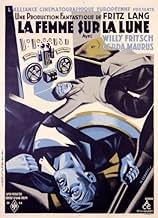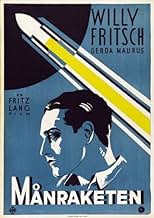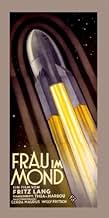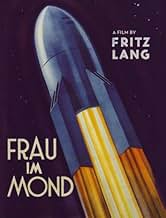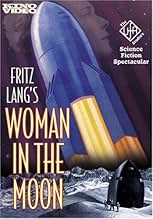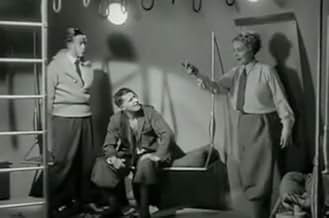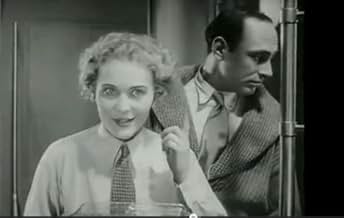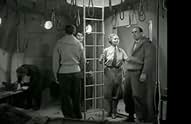AVALIAÇÃO DA IMDb
7,2/10
4,1 mil
SUA AVALIAÇÃO
Adicionar um enredo no seu idiomaA tenacious scientist blasts off for the moon in hopes of riches that may be found there.A tenacious scientist blasts off for the moon in hopes of riches that may be found there.A tenacious scientist blasts off for the moon in hopes of riches that may be found there.
- Prêmios
- 1 indicação no total
Gustl Gstettenbaur
- Gustav
- (as Gustl Stark-Gstettenbaur)
Gustav von Wangenheim
- Hans Windegger - Engineer
- (as Gustav v. Wangenheim)
Alexa von Porembsky
- Eine Veilchenverkäuferin
- (as Alexa v. Porembska)
Heinrich Gotho
- Der Mieter vom II. Stock
- (as Gotho)
Alfred Loretto
- Zwei eindeutige Existenzen
- (as Loretto)
Max Maximilian
- Grotjan, Chauffeur bei Helius
- (as Maximilian)
Edgar Pauly
- Zwei eindeutige Existenzen
- (as Pauly)
Karl Platen
- Der Mann am Mikrophon
- (as Platen)
Mahmud Terja Bey
- Fünf Gehirne und Scheckbücher
- (as Terja Bey)
Hermann Vallentin
- Fünf Gehirne und Scheckbücher
- (as Vallentin)
Avaliações em destaque
This was Fritz Lang's last silent film. It is a science fiction adventure in which a scientist, Professor Georg Manfeldt, had theorized that there were large supplies of gold on the moon. He was ridiculed by his peers and disgraced because of this. However, a wealthy industrialist believes Manfeldt's theory and has been building a rocket to travel to the moon. when a group of wealthy men who control the world's gold supply feel threatened by the possibility the theory may be correct, they threaten to destroy the rocket unless one of their agents, Turner, is allowed to go on the expedition too. Apparently Lang's film got so much right about space travel that the Germans seized the models used in the film as state secrets when they started their own rocket-building program. This film runs 169 minutes and is quite slow in places. It has some very interesting and thrilling scenes, but it is probably one of the weaker of Lang's films that I have seen.
Let's face it 'Woman in the Moon' is hardly one of the great Fritz Lang's best efforts: far, far too long, badly paced, ludicrously over-melodramatic and just plain silly. Nevertheless, it contains prescient details in regards to space travel and (as should be expected) looks absolutely fabulous. Lang even made claims that this was the first film to feature a rocket launch countdown and who are we to question him? One thing you can be certain of is that going to the moon would never again look so stylish. Even though this is the tail end of Lang's classic silent period, those who love films like 'Dr. Mabuse' and 'Spies' will still find much to enjoy here.
Silent films have always intrigued me, not all of them have held up but even then it is not to not appreciate what they tried to do. Those that do hold up though manage to be good and more films, and the best remarkable for their time and influential in cinema and their genres. Also like to love a lot of Fritz Lang's work, his best and most influential being 'Metropolis' and 'M' and 'You Only Live Once' and 'Scarlet Street' are also fabulous films.
'The Woman in the Moon' is not one of the best silent films. It is not one of Lang's best. And it is not one of the best of its genre. Other films at the time in all three respects have aged better by today's standards and in no way is that meant to sound ignorant or disrespectful, just my thoughts. 'The Woman in the Moon' is though very interesting if lesser Lang, with a number of standout things that still impress. In no way is it a bad film and really do appreciate the amount of effort that went into it.
It is a fairly easy film to criticise. It does have quite severe pacing problems, the overstretching of the plot really making the film drag badly. What would have made things better was if the film was much shorter as it does feel at least half an hour too long.
What particularly made 'The Woman in the Moon' feel like that was the romance, which is really not all that interesting, is pretty simplistic and is quite melodramatic. Further disadvantaged by being over-acted to the heavens by the actors. The professor character is also on the histrionic side.
Conversely, 'The Woman in the Moon' is hugely impressive visually still. There is a lot of atmospheric and very stylish camera work and the design and effects still look imaginative and like a lot of creativity went into making them. The take-off especially is pretty jaw-dropping in this aspect. Lang's direction shows enough flashes of brilliance, with some inspired sinister touches. The later interpolated music score is haunting and moves things along with a good sense of pace and atmosphere.
Although narratively the story is inconsistent, there are fine moments with the more scientific space-oriented element to it actually being quite intriguing and leaving one in awe. The build up to the take-off has tension, and, on top of being the most visually inspired the film gets, the take-off itself evokes thrills and jaws will likely drop looking at how good it still looks and how creatively it's handled.
On the whole, interesting but uneven and lesser Lang. 6/10
'The Woman in the Moon' is not one of the best silent films. It is not one of Lang's best. And it is not one of the best of its genre. Other films at the time in all three respects have aged better by today's standards and in no way is that meant to sound ignorant or disrespectful, just my thoughts. 'The Woman in the Moon' is though very interesting if lesser Lang, with a number of standout things that still impress. In no way is it a bad film and really do appreciate the amount of effort that went into it.
It is a fairly easy film to criticise. It does have quite severe pacing problems, the overstretching of the plot really making the film drag badly. What would have made things better was if the film was much shorter as it does feel at least half an hour too long.
What particularly made 'The Woman in the Moon' feel like that was the romance, which is really not all that interesting, is pretty simplistic and is quite melodramatic. Further disadvantaged by being over-acted to the heavens by the actors. The professor character is also on the histrionic side.
Conversely, 'The Woman in the Moon' is hugely impressive visually still. There is a lot of atmospheric and very stylish camera work and the design and effects still look imaginative and like a lot of creativity went into making them. The take-off especially is pretty jaw-dropping in this aspect. Lang's direction shows enough flashes of brilliance, with some inspired sinister touches. The later interpolated music score is haunting and moves things along with a good sense of pace and atmosphere.
Although narratively the story is inconsistent, there are fine moments with the more scientific space-oriented element to it actually being quite intriguing and leaving one in awe. The build up to the take-off has tension, and, on top of being the most visually inspired the film gets, the take-off itself evokes thrills and jaws will likely drop looking at how good it still looks and how creatively it's handled.
On the whole, interesting but uneven and lesser Lang. 6/10
The first half of this film; the set-up of the flight, the introduction to the main characters, a love triangle, and an international conspiracy; is frankly boring. But once the flight begins, action tenses up and things get interesting.
For 1929, the science is sometimes prescient-- a three stage rocket, a vertical assembly building, and a monstrous rolling gantry crawler-- are suggestive of the Apollo program. Other times the science is more romantic, using dowsing rods and an egg-shaped moon. The eggy moon allows a far-side with a breathable atmosphere. But an eggy moon really isn't less scientific than faster than light travel, which is a staple of modern space flight science fiction. FTL travel is simply a mechanism whereby a cast of characters can visit multiple star systems; the eggy moon allows the visit to a breathable world in the context of a 1930s Europe.
This movie understandably has fairly primitive special effects. One major effect, a rotating barrel decorated as the moon, is charming.
The ending is definitely touching. In the sub-genre of science fiction/space flight, this is an important and interesting film and well worth suffering through the first half.
For 1929, the science is sometimes prescient-- a three stage rocket, a vertical assembly building, and a monstrous rolling gantry crawler-- are suggestive of the Apollo program. Other times the science is more romantic, using dowsing rods and an egg-shaped moon. The eggy moon allows a far-side with a breathable atmosphere. But an eggy moon really isn't less scientific than faster than light travel, which is a staple of modern space flight science fiction. FTL travel is simply a mechanism whereby a cast of characters can visit multiple star systems; the eggy moon allows the visit to a breathable world in the context of a 1930s Europe.
This movie understandably has fairly primitive special effects. One major effect, a rotating barrel decorated as the moon, is charming.
The ending is definitely touching. In the sub-genre of science fiction/space flight, this is an important and interesting film and well worth suffering through the first half.
"Frau im mond" is undoubtedly one of the first and most important Sci-Fi movies ever made. Directed by Austrian director Fritz Lang best known for his masterpieces "M" and "Metropolis", it's a story of a half-mad greedy scientist obsessed with the idea of getting gold from the moon and a moon expedition that follows, there is also a love story that goes along. The look of the film is quite impressive, considered that it was made in 1929. Hitler later banned it, because the spaceship featured there was nearly identical to V-2s that were constructed in secrecy by the Third Reich at the time. An early Sci-Fi classic, a must see for any serious Sci-Fi fan. 8/10
Você sabia?
- CuriosidadesThis film shows the first countdown to the launch of a rocket - not just the first one in a movie, but the first ever. It was invented as a dramatic device for the movie. Previously, all launches were begun with a count upward from zero to a designated number (usually ten). Also depicted for the first time are the use of liquid rocket fuel, a rocket with two stages, and zero gravity in space.
- Erros de gravaçãoWhen Helius listens for Friede's heartbeat, fearing that the launch may have killed her, we can see her breathing heavily.
- Citações
[Opening intertitle]
The Author: "Never" does not exist for the human mind... only "Not yet."
- Cenas durante ou pós-créditosFritz Rasp is billed in the opening credits as "Der Mann, der sich Walter Turner nennt" or "The man who calls himself Walter Turner."
- Versões alternativasThe film was given a release from Kino Internation on DVD, running a length of 169 minutes. The 2000 restoration runs 200 minutes. The original showing in the United States ran 156 minutes and was later cut to 95 minutes.
- ConexõesEdited into Histoire(s) du cinéma: Le contrôle de l'univers (1999)
- Trilhas sonorasHeimlich singt für uns die Liebe
Music by Willy Schmidt-Gentner
Lyrics by Fritz Rotter
Sung by Gerda Maurus and Willy Fritsch
Principais escolhas
Faça login para avaliar e ver a lista de recomendações personalizadas
- How long is Woman in the Moon?Fornecido pela Alexa
Detalhes
- Data de lançamento
- País de origem
- Idioma
- Também conhecido como
- Woman in the Moon
- Locações de filme
- Empresas de produção
- Consulte mais créditos da empresa na IMDbPro
- Tempo de duração2 horas 36 minutos
- Mixagem de som
- Proporção
- 1.33 : 1
Contribua para esta página
Sugerir uma alteração ou adicionar conteúdo ausente

Principal brecha
By what name was A Mulher na Lua (1929) officially released in India in English?
Responda
